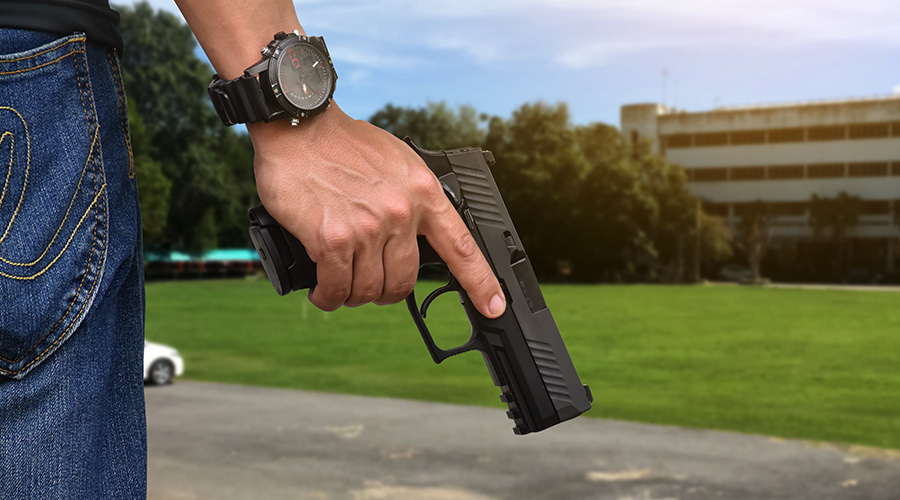Keeping Security Out of Sight
Transparent security measures provide ways to address risks while respecting the importance of aesthetics
The world has changed dramatically in the year and a half since Sept. 11. Although many of the risks that are now of such concern existed before that date, the events of Sept. 11 were the catalyst to bring about real change in security planning. Security measures are adopted on the basis of perceived risk, and from a risk assessment standpoint, many occurrences have gone from “might happen” to “have happened.” Building owners and facility executives now see the responsibility for security differently.
For businesses, the need for increased security is apparent. Yet there are many cases where the businesses may not want the appearance of security to be obvious. Although government organizations usually make security a priority over aesthetics, corporate and private facilities often cannot afford to follow this policy. With government facilities, if a property requires 12-foot-chain-link fence with razor wire, then that is what is put into place.
So where does that leave facility executives at corporate and private organizations? Many are taking security to a new level: transparent security. Transparent security is strategy that addresses the need for security while respecting the importance of a low-key appearance.
Enabling Technology
Transparent security follows two lines, hard and soft. Hard includes equipment, specifically equipment that is designed to be discrete or invisible. Soft involves policies and a strategy known as Crime Prevention Through Environmental Design (CPTED). Occasionally, nonsecurity objects may be used to serve soft security purposes. In one recent application, maple trees were planted in a park specifically to prevent vehicles from travelling into a restricted area. The trees were part of the park, the placement was part of the security plan.
The concept of transparent security design is proactive. The idea is to look for potential problems and take steps to put invisible or unobtrusive material in place to mitigate the potential problem.
Technology is helping to make transparent security easier, and recent advances in the field of window films are an example. An optically clear film is available that can be applied to almost any window, providing a significant increase in protection. Window films provide several security advantages. Glass-fragmentation retention film actually strengthens the glass, increasing the force necessary to break the glass and prevents glass fragments from flying. Window film is relatively inexpensive and is typically done as a retrofit on existing glass. An added benefit is that when properly applied, glass fragmentation window film is invisible.
Glass fragmentation window film has been applied at facilities owned by such diverse organizations as NASDAQ, Wells Fargo, and not surprisingly, the Department of Defense.
The idea of hiding security devices is not new. Manufacturers have been building hidden or low-profile closed-circuit television camera housings for years. Intrusion-detection equipment has also been available in hidden housings. Now, manufacturers of high-security vehicle barriers have followed suit. The vehicle barrier approach is unusual in that high-strength antivehicle bollards are now available in an ornamental configuration. One manufacturer has created a line of architecturally designed fiberglass and plastic sleeves to slip over bollards.
These ornamental barriers are being used to protect buildings as well as to control vehicle access in residential areas. In California, West Hollywood is employing the same type of antiterrorism bollards as used by the federal government to stop car bombers. The city’s barriers are used to block off residential areas from nighttime traffic off Sunset Boulevard from the new Sunset Millennium Shopping Center. The high-security barriers will stop vehicles weighing as much as 7 tons travelling at speeds of up to 62 miles per hour.
Security Meets Design
On the other side of the country, multiple entrances to the Florida State Capitol Building rate protection as well. High-security decorative bollard systems are proposed for the legislative members’ garage that will blend in with the aesthetics of the building. This system balances strength and design by placing ornamental trim around the perimeter of each bollard. In a crash test, the same bollards stopped a 7.5 ton vehicle traveling at 44 miles per hour. Mixing strength and aesthetics, these bollards carry a U.S. Department of State and Department of Defense rating of K8, L2, the highest rating that the government has given to a bollard system.
The impact of security is evident in perimeter systems, too. Some facilities are blending designs into the metal perimeter fence construction to reduce the visual impact of the fence. The corporate headquarters for Delta Airlines in Atlanta is surrounded by a fence with the Delta logo incorporated into it. Less than 10 miles away, the corporate headquarters for the Southern Company — parent company to Georgia Power and other utilities — sports lightning bolts bent into the metalwork of the perimeter fence. In both cases, the additional metal does nothing to increase the physical security.
CPTED takes the built environment and carefully modifies it to increase security. The concept has been used by planners and architects for many years to control behavior; the emphasis is on the placement of existing nonsecurity materials to achieve a security benefit.
CPTED classifies people as either normal users, abnormal users or observers. Normal users are the people that belong in a facility. They are the employees, the guy who fills the drink machine, the customers and anyone else who has legitimate business in a facility. The abnormal users are the opposite of the normal users. They are the thieves, the vandals, the graffiti artists and everyone else who is to be kept away.
The idea of letting some people in while keeping others out is at the heart of any access control system. What makes CPTED different is the idea of observers. A CPTED observer is a person who has been placed at a specific location to minimize the probability of a crime. The concept is simple: The more people looking at something, the less likely crime is to occur. As the number of people looking is increased, so is the probability that someone committing a crime will be seen, and therefore identified and caught.
Visibility Matters
Observers are not told that they are “observers.” They are not there to watch a location and report any crime. But reasonable people are is likely to call 911 if they witness a crime. Thus, security in crime-prone areas can be improved if there are reasons for someone — the observer — to be present. For example, park benches provide a place for people to sit, and as a result, they become places for observers to gather. From a design perspective, an observer is a transparent security measure.
CPTED also utilizes the concept of taking high-risk activities and placing them in low-risk areas to minimize the potential for crime. This is done without the use of security devices and is also transparent. Bank ATMs, for example, are inherently high-risk. The transparent goal in providing security for an ATM is to place the machine in an area of high visibility.
As the need for security continues to increase, transparent security design is becoming a factor in good architectural and security planning. Minor changes can make a big difference, without compromising aesthetics.
Contributing editor Jeffrey A. Dingle, CPP, is corporate security manager for The Home Depot.
Related Topics:











